Staten Island has long been the city’s slowest-growing borough, but the administration of Mayor Bill de Blasio is pushing it to develop more housing. Last Wednesday, the Department of City Planning organized a public forum on the mayor’s plan to rezone Bay Street, an industrial swath of Staten Island’s north shore, in order to encourage new apartments and retail.
“Given this borough’s history of wild west development… it’s no wonder Staten Islanders of all stripes cringe at the idea of more housing, whether luxury, market-rate, or affordable,” Borough President Jimmy Oddo said at the meeting.
The rezoning aims to transform a 14-block stretch of Bay Street in Tompkinsville and Stapleton, starting in the north at Victory Boulevard and running down to Sands Street. It could add as many as 2,557 apartments, 6,900 new residents, and 600,000 square feet of commercial space to the area, but that’s not what has neighbors and local politicians really fired up.
The Staten Island Advance’s Anna Sanders pulled out the most controversial tidbit from the city’s initial zoning documents: buildings as tall as 16 stories could rise on a large industrial site between Bay and Minthorne Streets, at the northern edge of the Bay Street corridor.
“Along the Bay street corridor, height matters,” Oddo emphasized during last week’s gathering. “There will be no 16-story building on this corridor.”
Three more blocks along Bay Street would have new building heights capped at 125 feet, and zoning on the remaining blocks would limit new construction to between five and eight stories.
A two-block stretch of Canal Street between Tappan Park and Broad Street would also get upzoned, but for relatively short developments that could only reach up to five stories.
Both the Canal and Bay Street Corridors would be affected by the mayor’s new Mandatory Inclusionary Housing policy, which requires builders to set aside at least a quarter of their units as affordable housing. The local City Council member, Debi Rose, will be able to negotiate one of four affordable options for new developments. Those range from renting 20 percent of the units to families earning 40 percent of the Area Median Income ($31,080 for a household of three) to the “workforce housing option,” which requires 30 percent of units at 115 percent AMI ($89,355 for a three-person household).
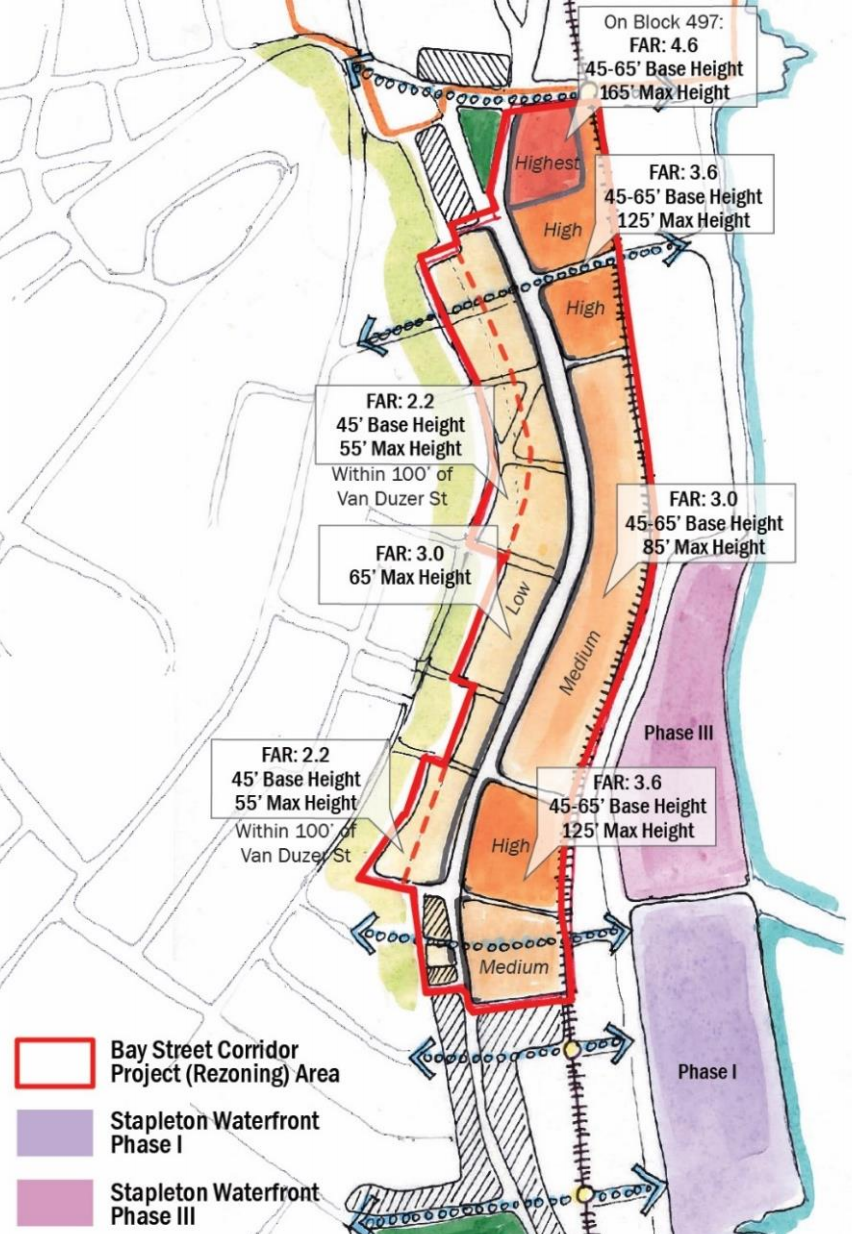
Map of the planned Bay Street corridor rezoning, via DCP
Oddo said he wanted workforce housing for even higher income levels, targeting families making as much as 150 percent AMI, or $122,400 for a household of three.
On Wednesday night, about a hundred people packed into a small meeting room at Trinity Lutheran Church on St. Paul’s Avenue, sweating on folding chairs and standing at the back of the room after all the seats filled. They listened as DCP officials drily summarized the first zoning documents for the area, which were posted on the agency’s website last month. But when community members finally got a chance to speak, they made it clear that parking and infrastructure would become major sticking points.
Like every neighborhood in New York City, folks here resent City Hall’s intrusion into their lives. They envision more people squeezed into crowded schools, struggling hospitals, and barely maintained transportation systems.
But unlike the other four boroughs, Staten Island has extremely high rates of car ownership. Parking lanes line both sides of many narrow, winding streets in the North Shore, and many of the older houses don’t have driveways. Although new construction could add up to 1,700 new parking spots, neighbors felt that simply wouldn’t be enough to accommodate 7,000 more residents.
“People are happy about renovation, about Lighthouse Point, about the wheel, about Empire Outlets,” said Glen Mancuso, the Vice President of the Staten Island Business Alliance. “But it always comes down to transportation and parking.”
He added that the city needs to get crime and drug use in the neighborhood under control. “I have prostitutes in the alleyway next to my building in the middle of the day… and people coming into my office and ask me for money in the middle of the day.”
North Shore City Council Member Debi Rose said the area needed dramatic infrastructure upgrades to accommodate all this new density. She demanded a new educational complex on the site of the former Samuel R. Smith Infirmary, improved health care facilities, a new recreational center to replace the now-demolished Cromwell Center, and upgraded sewers and street lighting.
Other attendees suggested that the city develop part of the old Homeport site – a former Navy base along the Stapleton waterfront – into a park and a school. Ironstate is already developing part of the desolate property into 900 apartments, and the next phase of construction is expected to bring the number of new units up to 1,500.
Mike Penrose, who worked with DCP on a local advisory committee for the rezoning, noted that it would bring a lot of new residents to an area that was devastated by Hurricane Sandy. “How will we accommodate 10,000 new people?” he asked. “And the building heights are out of context with Stapleton, and frankly confusing given what I’ve heard for the last 12 months as a planning committee advisory member.”
Subscribe to the YIMBY newsletter for weekly uxpdates on New York’s top projects
Subscribe to YIMBY’s daily e-mail
Follow YIMBYgram for real-time photo updates
Like YIMBY on Facebook
Follow YIMBY’s Twitter for the latest in YIMBYnews

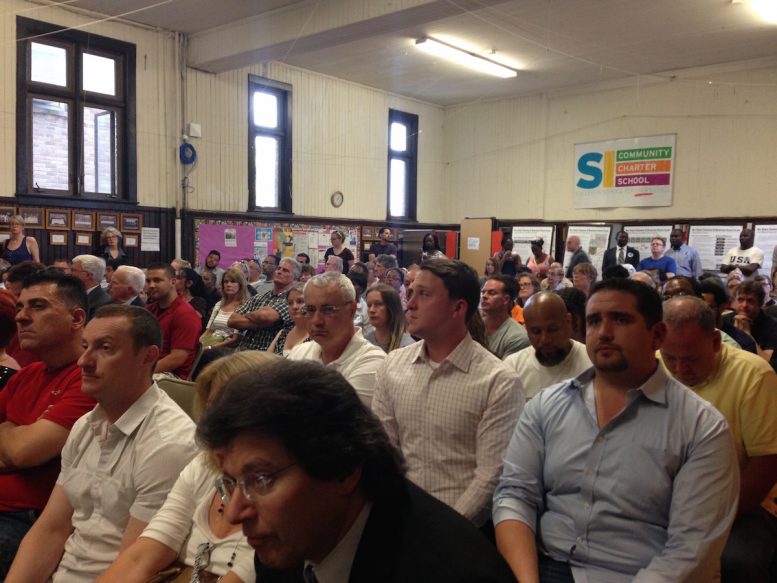
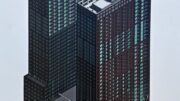
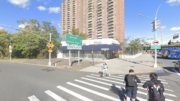
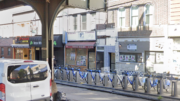
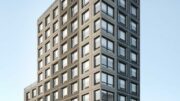
No one ever moved to Staten Island to live in an apartment.
Actually there are more renters on SI than most people think. Median rents for a 3BR are up to a surprising $1950/month.
S.I. cannot support any 16 story buildings. The entire island of 474,558 people is only served by 3 water/sewer plants. This one building will lower water pressure all over the north shore.
Correction – only TWO water/sewer treatment plants serve all of Staten Island. Port Richmond built in 1953, and Oakwood Beach built in 1956.
. Manhattan has 1 huge plant, Bronx has 2 medium plants.
Plans they can do
1 Get some sewage in Northeast SI to Brooklyn or
2 Expand the plants
3 Build a plant in Freshkills and it will convert the sewage into clean water. This is not new, in Israel 90% of sewage becomes water in Spain 20%.. This plant should be medium size (holds as much as the other 2)
That can clear up the problem and allow 16 or even 20 (lol Staten Island getting a 250 foot tower) story skyscraper